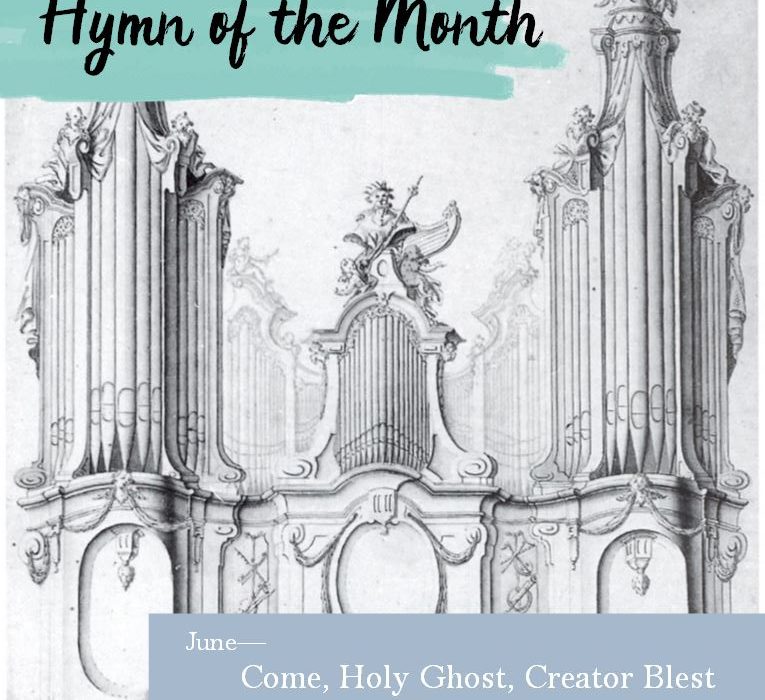Hymn of the Month
Come, Holy Ghost, Creator Blest (LSB 498)
The feasts of Pentecost and Holy Trinity are—to put it colloquially—our last “big shabang” before the onset of the usual summer chaos. To put it less colloquially, these holy days are the conclusion of our Easter celebrations and entrance into the season of the Church.
After Jesus rose from the grave (Easter) and ascended into heaven (Ascension), He sent the Holy Spirit upon His disciples on the day known as Pentecost. This is the story with the famous tongues of fire atop the disciples’ heads, and lots of speaking the Gospel in different languages (see Acts 2). By anointing His disciples with the Spirit, Jesus ordains them as pastors in His Church and gives them His authority to stand “in the stead and by the command of my Lord Jesus Christ.” Through that ordination, our pastors can rightfully deliver the Word and Sacraments to us, the Church, just as Christ Himself. So really, Pentecost is a celebration of Jesus’ providing for His Church from the time He ascended until the time when He comes again in glory.
Exactly one Sunday after Pentecost, we hail the Feast of the Holy Trinity. This day might seem a little weird at first, since it seems to celebrate a doctrine (i.e., teaching) more than an event from Jesus’ life. But if you think about it, it makes perfect sense to kick off the Pentecost season with this feast. The “green days,” as the season from the Feast of Pentecost until the end of the church year is often called (basically June-November), are called “green” because they are a time of life and growth in the Church. Now, if we who are the Church are going to live and grow, we had better know Who it is that we are living and growing into. That Who is God Himself: the Father, Son, and Holy Spirit. The Trinity, in other words. And what better way to begin our season of growth than by learning about this Trinity.
Cue the hymn of the month! The Holy Spirit, Who “calls, enlightens, and sanctifies us in the one true Faith,” is the subject of our prayer in the hymn “Come, Holy Ghost, Creator Blest.” He is the one who descended at Pentecost, and it is He who teaches us to know the Holy Trinity rightly. And so we pray here that he “come with Your grace and heavenly aid, and fill the hearts which You have made” (st. 1).
In all honesty, “Come, Holy Ghost, Creator Blest” is one of the Church’s greatest hymns on the work of the Holy Spirit. Ranked right up there with the Te Deum (the canticle in Matins), it is the most famous of the ancient Latin hymns, standing the test of time for good reason. It uses key scriptural passages to teach us about the Spirit and His work throughout the prayer. For example, in stanza two, we address Him as the Counselor, the name Jesus uses when He tells us that He will send the Spirit (John 14, 15), and we call Him the “font of Life” in reference to our baptismal birth. Stanza three mentions the sevenfold graces named in Isaiah 11:2: wisdom, understanding, counsel, might, knowledge, the fear of the Lord, and piety. Recalling Psalm 23 and the Lord’s Prayer, we invoke the Spirit as the one who drives away our “wily foe” and protects us from the evil one. In stanza six, we ask Him to be our Catechist, or teacher of the Faith, that we may know the Triune God in truth and purity. Finally, we end in glorious doxology, praising the Father, Son, and Holy Spirit forever.
Now it’s time to count your lucky stars. In benevolent mercy, your dear deaconess has suggested hymn 498 instead of 499 as the hymn of the month. Flip open a hymnal and take a look: they are identical hymns in terms of the lyrics… but… those melodies! Actually, the melodies are almost the same too, but thanks to Martin Luther, 498 is an easier version of 499. You see, in the pre-Reformation Roman Catholic church, the choir did most of the singing. Hence all those gorgeous Gregorian chants that would be impossible for a congregation of serfs and peasants to sing. One of the reforms Luther made was to put the song of the Church back into the mouth of the common man; and this meant that the songs had to be the kind that normal people can sing. So, instead of using the flowing plainsong tune that has syllables changing on unexpected beats, Luther tweaked the melody to be entirely syllabic, so that all the words fit with the beats. If that’s not a reason to praise God, I don’t know what is.
Now, armed with this beautiful prayer to the Spirit, the Church of God may march forth into the season of Pentecost. Let us praise the Trinity for His unending love and mercy, and let us pray to the Holy Spirit to preserve us unto life everlasting!



